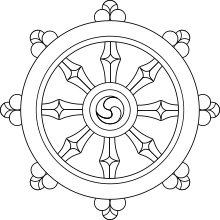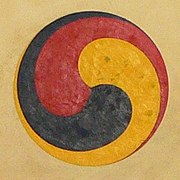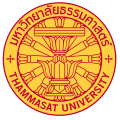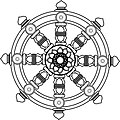Dharmachakra
| Part of a series on |
| Buddhism |
|---|
 |
The dharmachakra Sanskrit: धम्मचक्र; Pāli: dharmacakka; Burmese: ဓမ္မစကြာ ([dəməseʔ tɕà]); Chinese: 法輪; pinyin: fălún; Standard Tibetan: འཁོར་ལོ། (chos kyi 'khor lo); Template:Dabbr "Wheel of Dharma" or "Wheel of Life") is a symbol that has represented dharma, the Buddha's teaching of the path to enlightenment, since the early period of Indian Buddhism.[1] A similar symbol is also in use in Jainism.[citation needed] It is one of the Ashtamangala symbols.[citation needed]
History
The dharmacakra is one of the oldest known Buddhist symbols found in Indian art, appearing with the first surviving post-Harappan Indian iconography in the time of the Buddhist king Aśoka.[2] It has been used by Buddhist nations as a symbol ever since. In its simplest form, the Dharmachakra is recognized globally as a symbol for Buddhism.[3] The Ashoka Chakra with 24 spokes, appears on the Lion Capital of Sarnath, the official Emblem of India and is represented at the center of the Flag of India.
Symbolism

In Buddhism, according to the Pali Canon (Vinayapitaka, Khandhaka, Mahavagga, and Dhammacakkappavattanasutta), the number of spokes of the dharmacakra represent various meanings:
- Eight spokes representing the Noble Eightfold Path (Ariya magga).
- Eight laws relating to the vicissitude of life or a reminder to stay neutral in the face of these eight laws (Attha Loka Dhamma).[4]
- 12 spokes representing the twelve laws of dependent origination (Paticcasamuppāda) or the twelve permutations of the four noble truths.[5]
- 24 spokes representing the twelve laws of dependent origination and the twelve laws of dependent termination (paticcasamuppāda).
- 31 spokes representing 31 realms of existence (11 realms of desire, 16 realms of form and four realms of formlessness).
In Buddhism, the parts of the dharmacakra also represent:
- Its overall shape is that of a circle (cakra), representing the perfection of the dharma teaching
- The hub stands for discipline, which is the essential core of meditation practice
- The rim, which holds the spokes, refers to mindfulness or samādhi which holds everything together
- Each spoke represents a portion of the Noble Eightfold Path including
- Right beliefs
- Right aspirations
- Right speech
- Right conduct
- Right livelihood
- Right effort
- Right mindfulness
- Right meditational attainment
The corresponding mudrā, or symbolic hand gesture, is known as the dharmacakra mudrā.
The dharmacakra is one of the eight auspicious symbols of Tibetan Buddhism.
According to Hindu religion, Puranas mentioned that only 24 Rishis wielded the whole power of the Gayatri Mantra. These 24 rishi in Himalayas are represented through the 24 letters of Gayatri Mantra. The all the 24 spokes of Dharmachakra are representation of all these 24 rishi of Himalayas in which Vishvamitra is first and Yajnavalkya is last who governs the religion (Dharma).
24 Spokes of Dharmachakra according Hindu religion:
1. Love
2. Courage
3. Patience
4. Peacefulness
5. Magnanimity
6. Goodness
7. Faithfulness
8. Gentleness
9. Selflessness
10. Self-Control
11. Self Sacrifice
12. Truthfulness
13. Righteousness
14. Justice
15. Mercy
16. Gracefulness
17. Humility
18. Empathy
19. Sympathy
20.Spiritual Knowledge
21. Moral Values
22. Spiritual Wisdom
23. The Fear of God
24. Faith or Belief or Hope
The dharma wheel can refer to the dissemination of the dharma teaching from country to country. In this sense the dharma wheel began rolling in India, carried on to Central Asia, and then arrived in South East Asia and East Asia.
Multiple turnings of the Wheel

Mahayana schools classify Buddhist teachings in turns of a sequential scheme of development. These phases are called "turnings" of the dharmacakra (Sanskrit: dharmacakra-pravartana).
All Buddhists agree that the original turning of the wheel occurred when the Buddha taught the five ascetics who became his first disciples at the Deer Park in Sarnath. In memory of this, the Dharmacakra is sometimes represented with a deer on each side.
In Theravāda Buddhism, this was the only "turning of the wheel", and later developments of the Buddhist doctrine which do not appear in the Pali Canon or the Agamas are not accepted as teachings of the historical Buddha.
Other schools of Buddhism, such as the Mahāyāna and Vajrayāna distinguish later "turnings". Specific accounts of them vary. In one, the first turning of the dharmacakra is Gautama Buddha's original teaching, in particular the Four Noble Truths which describes the mechanics of attachment, desire, suffering, and liberation via the Eightfold Path; the second turning is the teaching of the Perfection of Wisdom sutra, a foundational text of Mahayana Buddhism; and the third is the teaching of the Mahavairocana Sutra, a foundational text of Tantric Buddhism.
In another scheme, the second turning of the dharmacakra is the Abhidharma, the third is the Mahāyāna Perfection of Wisdom Sutras, and the fourth includes both the Yogacara sutras and Tathāgatagarbha sutras.
Other uses
- In the Unicode computer standard, the Dharmacakra is called the "Wheel of Dharma" and found in the eight-spoked form. It is represented as U+2638 (☸).
- The coat of arms of Mongolia includes a dharmacakra together with some other Buddhist attributes such as the lotus, cintamani, blue khata and Soyombo.
- Following the suggestion of Bhimrao Ambedkar, the Buddhist dharmacakra was used on the new Flag of India.[6]
- The national flag of the former Kingdom of Sikkim in the Himalayas featured a version of the Dharmacakra.
- Thai people also use a yellow flag with a red Dharmacakra as their Buddhist flag.
- The Dharmacakra is also the U.S. Armed Forces military chaplain insignia for Buddhist chaplains.
- In Jainism, the Dharmacakra is worshipped as a symbol of the dharma.[citation needed]
- Other "cakras" appear in other Indian traditions, e.g. Vishnu's Sudarśanacakra, which is, however, a wheel-shaped weapon and not a representation of a teaching.
- In non-buddhist cultural contexts, an eight-spoked Dharmacakra resembles a traditional ship's wheel. As a nautical emblem, this image is a common sailor tattoo.
-
The Coat of arms of Sri Lanka, featuring a blue Dharmacakra as the crest
-
The flag of the former Kingdom of Sikkim featured a version of the Dharmacakra
-
The Dharmacakra flag, symbol of Buddhism in Thailand
-
Thammachak (Dharmacakra) Seal, seal of Thammasat University in Thailand, consisting of a Constitution on Phan or container with the 12-spoked Dharmacakra behind
-
Dharmacakra for the U.S. Armed Forces military chaplain
Dharmacakra in Falun Gong
Dharmacakra is translated as Falun in Chinese, and is therefore the most important thing in Falun Gong practice. In "The Great Consummation Way of Falun Dafa", Li Hongzhi explains, "The rotating Law Wheel has the same nature as the universe and as its miniature. The Buddhist Law Wheel, the Daoist yin-yang, and everything in the Ten-Directional World are reflected in the Law Wheel. The Law Wheel provides salvation to the cultivator when it rotates inward (clockwise), since it absorbs a great amount of energy from the universe and transforms it. The Law Wheel provides salvation to others when rotating outward (counter-clockwise), for it releases energy that can save any being and rectify any abnormal condition; people near the cultivator benefit."[7]
See also
- Ashtamangala
- Bhavacakra
- Chakravarti
- Coat of arms of Mongolia
- Coat of arms of Sri Lanka
- Khorlo
- Prayer wheel
- Sun Chariot
- Surya
- Sephirot
Notes
- ^ Albert Grünwedel, Agnes C. Gibson, James Burgess,Buddhist art in India. Published by Bernard Quaritch, 1901, page 67: "The wheel (dharmachakra), as already mentioned, was adopted by Buddha's disciples as the symbol of his doctrine ..."
- ^ Albert Grünwedel, Agnes C. Gibson, James Burgess, Buddhist art in India. Published by Bernard Quaritch, 1901, page 67: "The wheel (dharmachakra), as already mentioned, was adopted by Buddha's disciples as the symbol of his doctrine, and combined with other symbols—a trident placed above it, etc.—stands for him on the sculptures of the Asoka period."
- ^ Hermann Goetz, The art of India: five thousand years of Indian art. Published by Crown, 1964, page 52: "dharmachakra, symbol of the Buddhist faith".
- ^ http://www.thebuddhism.net/2013/05/09/the-eight-laws-relating-to-the-vicissitude-of-life/
- ^ http://www.accesstoinsight.org/tipitaka/sn/sn56/sn56.011.than.html#fnt-3
- ^ Christopher S. Queen, Sallie B. King, Engaged Buddhism: Buddhist liberation movements in Asia. SUNY Press, 1996, page 27, [1]: "Ambedkar, as a member of Nehru's first cabinet, proposed the use of the Buddhist dharmachakra or "wheel of the law" on the new flag of India and the Ashokan lion-capital on the national currency."
- ^ [2]
Further reading
- Dorothy C. Donath (1971). Buddhism for the West: Theravāda, Mahāyāna and Vajrayāna; a comprehensive review of Buddhist history, philosophy, and teachings from the time of the Buddha to the present day. Julian Press. ISBN 0-07-017533-0.







